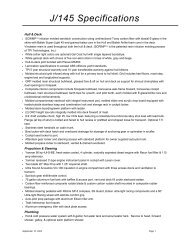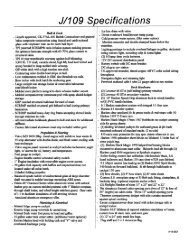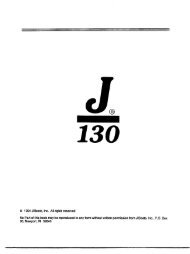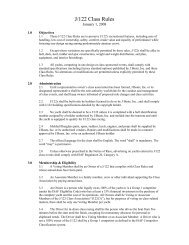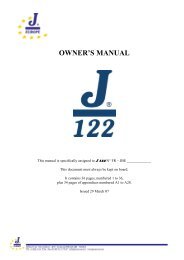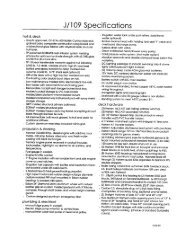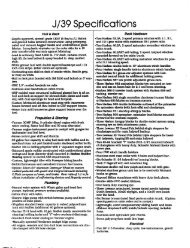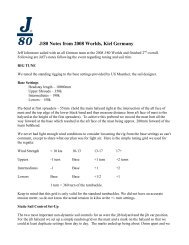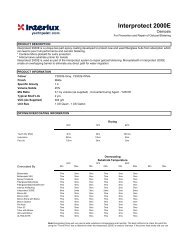J105 Owner Manual 2012.pdf - J/Owners
J105 Owner Manual 2012.pdf - J/Owners
J105 Owner Manual 2012.pdf - J/Owners
You also want an ePaper? Increase the reach of your titles
YUMPU automatically turns print PDFs into web optimized ePapers that Google loves.
J/105 <strong>Owner</strong> Guide ...................................................................................................................................................................................................................................................... 47 <br />
According to Triad Trailers, one should first load a trailer by placing most of the weight (80-‐<br />
90%) on the keel as it sits in the trailer’s keel tray. Then screw each individual hull support up to <br />
the hull just until light contact is made. Do this for each of the six individual hull support stands <br />
(on the Triad Trailer). After all six stands are touching the hull release the lifting straps so the <br />
boat is now mostly on the keel with the hull support stands preventing the boat from tipping side <br />
to side. Adjust each hull support stand upwards towards the hull to a point where you are only <br />
able to spin the carpeted top on the hull with a good amount of force. After each hull support <br />
stand is properly adjusted tighten the set screw on each of the 6 hull supports. This set screw <br />
prevents the wing nut handle from vibrating down during travel. <br />
Be particularly careful when strapping a boat down to the trailer. It’s not uncommon at regatta <br />
venues to see boats quickly hauled and lowered onto their trailers, with little time to get the boat <br />
aligned and sitting properly on the poppets, then strapped down hard onto the trailer with <br />
powerful ratcheting webbing straps and then driven off. In short, the hull is being pulled down <br />
hard on top of the keel/sump and in a very short period of time is potentially subjected to <br />
excessive stresses and strains on the entire hull/keel/sump structure. If you have a bow-‐stop on <br />
the trailer, use shorter strap runs (running nearly vertical) over the boat rather than long <br />
diagonal straps through the bow and stern rails. This reduces the possibility of trailer flex <br />
contributing to any excess strain. <br />
Docking & Mooring -‐ care should be taken to avoid mooring or docking your boat in locations that <br />
can result in the keel being occasionally imbedded in the mud/sand/silt when at low tide or low <br />
water. A combination of the keel bulb imbedded with any sort of wave action against the hull <br />
can cause undue stress to the hull and structure. The same is true for boats that use special <br />
dockside hoisting systems to hoist the hull out of the water, while the keel remains underwater <br />
and unsupported. <br />
Maintenance Considerations <br />
Care should be taken to avoid having standing water in the bilge. Not only does standing water <br />
accelerate corrosion of wiring, fasteners and keel bolts over time, it ruins floor boards and <br />
interior woodwork. As the gelcoat/ paint ages in the bilge area, bilge water can eventually seep <br />
into the fiberglass laminate by way of pin holes in the gelcoat and weaken the fiberglass laminate <br />
structure. The process of hydrolysis can be initiated in the fiberglass laminate anytime there is <br />
ingress through cracks in the paint/gelcoat in the bilge. The process of hydrolysis is persistent <br />
and invisible-‐ it's water that chemically degrades the quality and strength of the laminate over <br />
time. Bilges (all areas under the floorboards, not just the centerline bilge) should be cleaned <br />
thoroughly once per year and then every five years recoated with fresh gelcoat or epoxy paint to <br />
ensure proper protection. In northern climates, water turns to ice in the winter. If moisture gets <br />
into the laminate and freezes, this can rapidly accelerate deterioration in the laminate. The New <br />
Hampshire Materials Testing Labs website (www.nhml.com) has an informative article on <br />
hydrolysis, see Newsletter of May 1, 2006. <br />
In any cored hull, take special care to avoid having any fasteners penetrate the inner hull <br />
laminate. Water in the bilge area can easily weep through the fastener into the laminate and <br />
cause core damage. If you need to secure a fitting or wire tie to the hull, the best fastening <br />
method is to glue a piece of epoxy coated marine ply to the hull and then fasten into the ply. <br />
A growing trend amongst active one-‐design racers is to use a dehumidifier to keep the inside of <br />
the boat dry. This extra step not only keeps the boat a little lighter, but helps everything from <br />
wiring, to woodwork, to sails, last longer.



